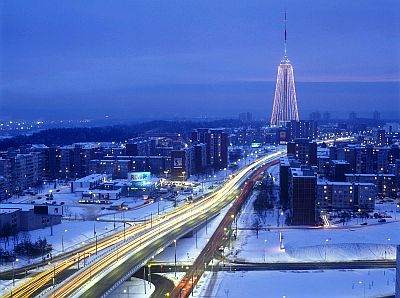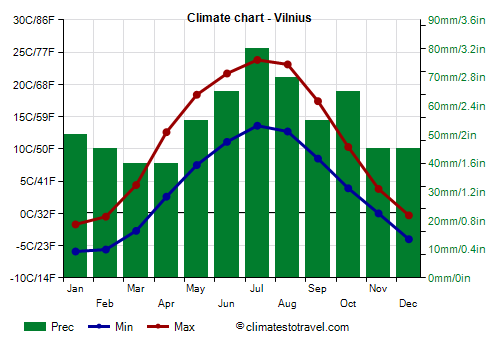Select units of measurement for the temperature and rainfall tables (metric or imperial).
Average weather, temperature, rainfall, sunshine
In Lithuania, a flat country overlooking the Baltic Sea, the climate is semi-continental, with very cold winters and mild, moderately rainy summers.
On the coast, the average
temperatures are just below freezing in January and February and around 18 °C (64 °F) in July and August. In inland areas, the temperatures are a bit lower in winter and a bit higher in summer.
Precipitation (rain or snow) are frequent throughout the year, however, in terms of quantity, there's a relative minimum between February and April. The coast, where precipitation amounts to about 750 millimeters (29.5 inches) per year, is rainier than the interior, where it drops to about 650 mm (25.5 in).
The
sun in Lithuania is rarely seen from November to February, while from May to August, it shines for a decent amount of time (the days are very long, so the total amount of sunshine is not low, even though the percentage is not very high). On average, there are around 1,800 hours of sunshine per year.
The climate in detail
The seasons
Winter is cold and dark: temperatures are often below freezing (0 °C or 32 °F), and landscapes are usually snow-covered from December to mid-March.
Snowfalls are frequent but not abundant, and often occur in the form of continuous but light snow.
The temperature decreases gradually towards the interior: the daily average in January and February is around -1 degrees Celsius (30 °F) on the coast (see Klaipeda), it slightly drops in the central area (see Kaunas), and even so more in the east, where it reaches -4 °C (25 °C) in Vilnius, which therefore is the coldest city in Lithuania.
The temperature can change a lot depending on meteorological situation. When currents come from the Atlantic Ocean, it can exceed freezing even in winter, while when
cold currents blow from Russia, it can plunge to -20 °C (-4 °F), and at times even to -30 °C (-22 °F).

In
spring, the temperature gradually increases, even though the weather remains cold for a few weeks. April is typically a cold month, and especially in the first half, there is still some chance of snow and frost, while in the second half, the first warm days can occur, brought by southerly winds. In general, the temperatures become pleasant in a stable manner from the middle of May.
Summer, from June to August, offers, in addition to very long days, pleasant temperatures. In July and August, highs are around 22 °C (71.5 °F) on the coast and around 23/24 °C (73/75 °F) in inland areas. However, summer is a fairly rainy season.
Sometimes,
warm currents from the southernmost plains of Eastern Europe can cause a considerable increase in temperature: in these cases, it can reach 25/30 °C (77/86 °F) on the coast and up to 30/35 °C (86/95 °F) in inland areas. However, these hot periods generally only last a few days.
Autumn is still quite pleasant in September, while by October, it becomes dull and rainy, and gradually colder over the weeks. The first snowfalls typically occur in late October or in November.
Klaipeda

In
Klaipeda, located on the coast, which, as we have said, is the mildest part of the country, the average temperature ranges from around -1 °C (30 °F) in January and February to 18.5 °C (65 °F) in July and August.
In Klaipeda, precipitation amounts to 735 millimeters (29 inches) per year, with a maximum in autumn.
The
Baltic Sea is near the freezing point in winter and is very cool in summer: the water temperature is around 2.5 °C (36.5 °F) in February and March, while in summer, it reaches 17 °C (62.5 °F) in July and 18.5 °C (65 °F) in August.
Vilnius

In
Vilnius, the capital, located in the easternmost part (ie the most continental) of the country, about 280 km (170 mi) from the coast, the average temperature ranges from around -4 °C (25 °F) in January to 18.7 °C (65.7 °F) in July.
In Vilnius, precipitation amounts to 660 mm (26 in), with a maximum in summer due to afternoon thunderstorms.
When to go
The best period to visit Lithuania is
summer, from June to August: the temperatures are pleasant, and sometimes even warm. Certainly, there is a moderate amount of rainfall, often in the form of thunderstorms in the afternoon, but there are also some nice days.
As it's often the case in Nordic countries, by mid-August, the summer already begins to decline, in fact, the rains become more frequent, and in any case, the days get shorter.
If you want to visit Lithuania in its
winter appearance, February is preferable to December because of the longer days.
What to pack
In
winter: bring very warm clothes, such as a down jacket, a hat, gloves, and a scarf.
In
summer: bring clothes for spring and autumn, being ready to add or remove the outer layer, a T-shirt, but also long pants, a jacket and a sweatshirt, and a raincoat or umbrella.
Climate data - Lithuania
| Kaunas |
|---|
|
| Jan | Feb | Mar | Apr | May | Jun | Jul | Aug | Sep | Oct | Nov | Dec |
|---|
| Min temp. | -5 | -5 | -2 | 3 | 7 | 11 | 13 | 13 | 9 | 4 | 1 | -3 |
|---|
| Max temp. | -1 | 0 | 5 | 13 | 19 | 22 | 24 | 23 | 18 | 11 | 5 | 1 |
|---|
| Precip. | 55 | 40 | 45 | 40 | 60 | 70 | 95 | 85 | 55 | 70 | 50 | 50 |
|---|
| Prec. days | 12 | 11 | 10 | 8 | 9 | 11 | 11 | 11 | 8 | 11 | 11 | 11 |
|---|
|
|
| Sun hours | 1 | 2 | 4 | 6 | 8 | 9 | 8 | 8 | 5 | 3 | 1 | 1 |
|---|
|
| Klaipeda |
|---|
|
| Jan | Feb | Mar | Apr | May | Jun | Jul | Aug | Sep | Oct | Nov | Dec |
|---|
| Min temp. | -3 | -3 | -1 | 3 | 8 | 12 | 15 | 15 | 11 | 6 | 2 | -1 |
|---|
| Max temp. | 1 | 1 | 4 | 11 | 16 | 19 | 22 | 22 | 18 | 12 | 6 | 3 |
|---|
| Precip. | 65 | 45 | 45 | 30 | 40 | 55 | 60 | 80 | 70 | 95 | 85 | 70 |
|---|
| Prec. days | 13 | 11 | 9 | 6 | 7 | 8 | 8 | 11 | 10 | 14 | 14 | 14 |
|---|
| Humidity | 88% | 87% | 82% | 75% | 75% | 77% | 78% | 77% | 79% | 83% | 88% | 89% |
|---|
| Day length | 8 | 10 | 12 | 14 | 16 | 17 | 17 | 15 | 13 | 10 | 8 | 7 |
|---|
| Sun hours | 1 | 2 | 4 | 6 | 9 | 10 | 9 | 8 | 6 | 3 | 1 | 1 |
|---|
| Sea temp | 4 | 3 | 2 | 4 | 8 | 13 | 17 | 18 | 16 | 12 | 9 | 6 |
|---|
| Panevezys |
|---|
|
| Jan | Feb | Mar | Apr | May | Jun | Jul | Aug | Sep | Oct | Nov | Dec |
|---|
| Min temp. | -5 | -4 | -3 | 3 | 6 | 11 | 13 | 12 | 8 | 5 | 0 | -4 |
|---|
| Max temp. | 0 | 2 | 4 | 12 | 17 | 22 | 24 | 23 | 18 | 11 | 4 | 0 |
|---|
| Precip. | 50 | 35 | 35 | 45 | 65 | 70 | 105 | 55 | 40 | 55 | 45 | 40 |
|---|
| Prec. days | 11 | 12 | 10 | 8 | 9 | 11 | 10 | 10 | 8 | 11 | 11 | 11 |
|---|
|
|
|
|
| Siauliai |
|---|
|
| Jan | Feb | Mar | Apr | May | Jun | Jul | Aug | Sep | Oct | Nov | Dec |
|---|
| Min temp. | -5 | -6 | -2 | 2 | 7 | 11 | 13 | 13 | 9 | 4 | 0 | -3 |
|---|
| Max temp. | 0 | 0 | 5 | 12 | 18 | 21 | 24 | 23 | 17 | 11 | 4 | 1 |
|---|
| Precip. | 45 | 35 | 35 | 35 | 55 | 70 | 80 | 70 | 55 | 70 | 50 | 45 |
|---|
| Prec. days | 11 | 10 | 9 | 7 | 9 | 10 | 10 | 10 | 9 | 12 | 11 | 12 |
|---|
|
|
| Sun hours | 1 | 2 | 4 | 6 | 8 | 9 | 8 | 8 | 6 | 3 | 1 | 1 |
|---|
|
| Vilnius |
|---|
|
| Jan | Feb | Mar | Apr | May | Jun | Jul | Aug | Sep | Oct | Nov | Dec |
|---|
| Min temp. | -6 | -6 | -3 | 3 | 8 | 11 | 14 | 13 | 8 | 4 | 0 | -4 |
|---|
| Max temp. | -2 | 0 | 4 | 13 | 18 | 22 | 24 | 23 | 17 | 10 | 4 | 0 |
|---|
| Precip. | 50 | 45 | 40 | 40 | 55 | 65 | 80 | 70 | 55 | 65 | 45 | 45 |
|---|
| Prec. days | 12 | 11 | 10 | 8 | 10 | 11 | 10 | 9 | 8 | 11 | 10 | 11 |
|---|
| Humidity | 90% | 87% | 78% | 66% | 66% | 69% | 72% | 73% | 79% | 85% | 91% | 92% |
|---|
| Day length | 8 | 10 | 12 | 14 | 16 | 17 | 17 | 15 | 13 | 10 | 8 | 7 |
|---|
| Sun hours | 1 | 3 | 4 | 5 | 8 | 8 | 7 | 7 | 5 | 3 | 1 | 1 |
|---|
|
See also the
temperatures month by month